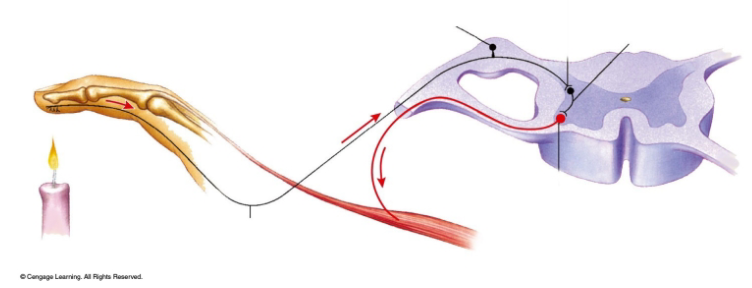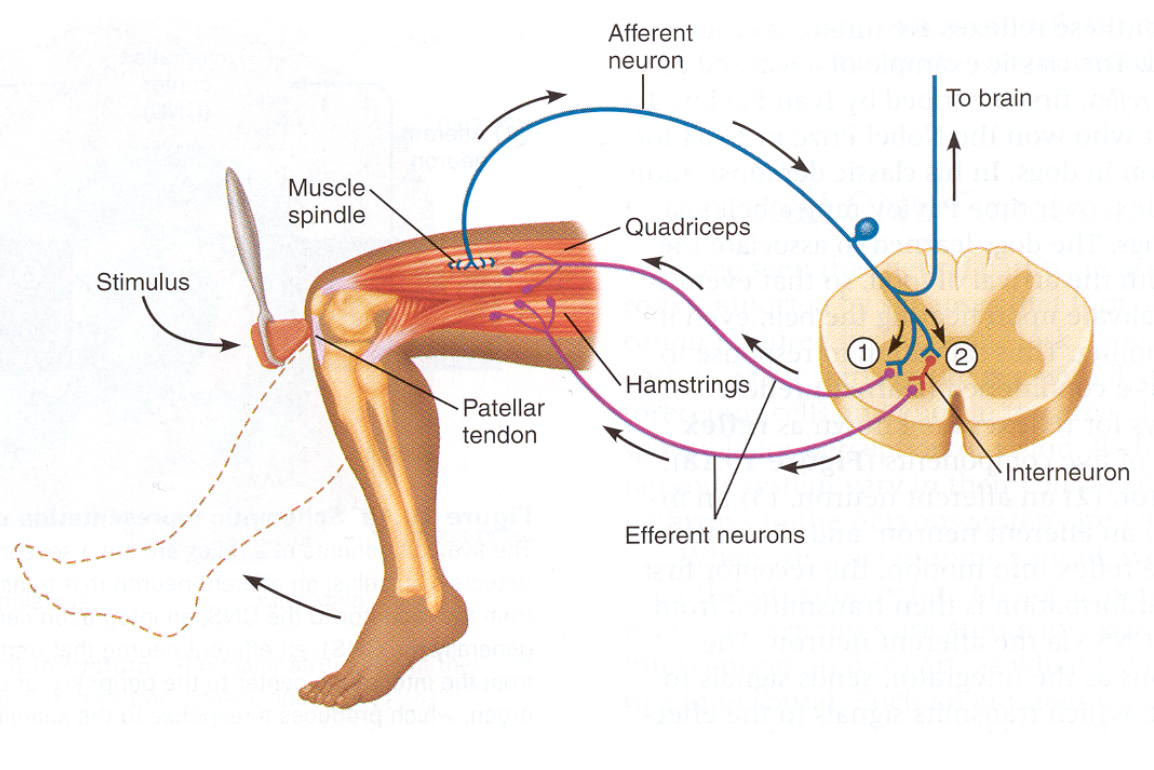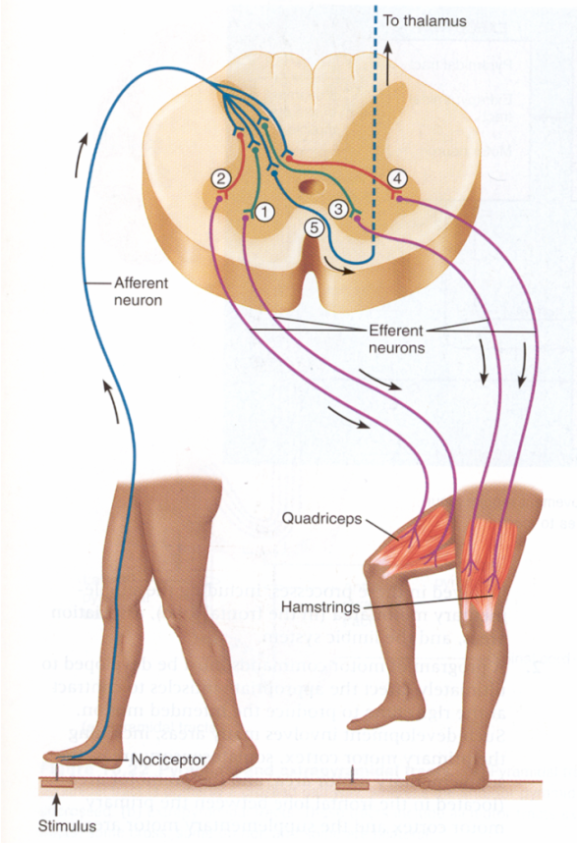Week 7
1/103
Earn XP
Name | Mastery | Learn | Test | Matching | Spaced |
|---|
No study sessions yet.
104 Terms
primary functions of the nervous system
→ receive information: environmental stimuli (external and internal)
→ translate (integrate) information: evaluate stimuli
→ send a response: initiate and send a response to the effector; coordinate rapid, immediate responses
→ location of nerve or nerve-like activity: all animals with tissues
→ exception: poriferans (sponges) → electrical regulation of porocytes
nerve nets in invertebrates
→ interconnected neurons, no central control point (ganglia or brain) for movement and response to stimuli
→ responses from multiple directions (good for detecting prey) and bidirectional
→ no separation of function (sensory, integration, motor)
→ clade radiata, phylum cnidaria and clade bilateria, phylum echinodermata
clade radiata, phylum cnidaria nerve nets
→ some jellyfish have two nets
→ slow-transmission net: coordinates tentacles
→ faster net: coordinates swimming
clade bilateria, phylum echinodermata nerve nets
→ modified nerve net (radial nervous system)
→ coordinates tube feet and arm movement
bilateral nervous systems
→ control point (ganglia or brain) and interconnected neurons for integration (stimulus intensity, direction, etc.) and coordination of movements and responses
→ the response is localized, unidirectional neurons, and separation of function (sensory, integration, motor)
→ phylum platyhelminthes, phylum annelida, phylum arthropoda, phylum cephalopoda
phylum platyhelminthes bilateral nervous system
→ the brain is necessary for full, coordinated, and adaptive responses
→ ganglion provides segmental (localized) control
→ nerve cord is solid and ventral
→ forward movement with some segments; elongating and other shorting at the same time
phylum arthropoda bilateral nervous system
→ insects have the largest brains in the phylum
→ workers have more neurons for learning, memory, olfactory processing
→ e.g., foraging ants count their steps → experiment: changing the length of ant’s legs
phylum cephalopoda
→ the brain is lobed and has intricate folds that are similar to vertebrates and regions are well-developed for specific functions (somewhat unique)
→ senses are well-developed
→ e.g., octopus
greatest brain size per body size of all animals
significant ability to learn, and perform difficult tasks (problem solve and use tools)
changes color, skin, and shape
overall trends in the evolution of the nervous system
→ the number of nerve cells increased
→ nerve cells became concentrated in specific areas (not simply spread throughout the body; ganglia, brain, nerve cord, and nerves)
→ specialization of function and regions (no longer like nerve net)
→ cephalization: concentration of sensory organs on the anterior end of the body
central nervous system (CNS)
integrates information and sends an appropriate response
→ brain (cranium) and spinal cord (vertebral column; dorsal, hollow tube)
nerves
→ cranial (12 pairs) and spinal nerves (32 pairs)
→ CNS connects to PNS
→ afferent, integration, and efferent nerves involved
peripheral nervous system (PNS)
connects to but lies outside the brain and spinal cord and carries information to and from body parts and regions
→ afferent nerves, efferent nerves, and integration
afferent nerves
carry information to CNS from sensory receptors
efferent nerves
carry information back to effectors from the CNS (homeostasis)
integration
occurs in CNS (information processing leading to a response)
divisions of the PNS
somatic and autonomic
somatic division of the PNS
skeletal muscle and skin, voluntary muscle movement (conscious activities)
autonomic division of the PNS
involuntary responses, control internal organs (viscera)
→ e.g., heart rate, blood flow, respiratory rate
divisions of the autonomic division of the PNS
parasympathetic and sympathetic
parasympathetic division of the autonomic division of the PNS
maintain minimal energy level, resting and digesting activities, neurotransmitter: acetylcholine
sympathetic division of the autonomic division of the PNS
mobilize energy, decrease non-vital functions, stimulate the adrenal gland (release epinephrine), fight or flight
autonomic nervous system (ANS)
helps maintain homeostasis since sympathetic and parasympathetic divisions generally work in opposite ways
→ enteric system which is embedded in the digestive tract is also part of the ANS
ANS functions on the pupil
→ sympathetic: dilation
→ parasympathetic: constriction
ANS functions on the heart
→ sympathetic: increased rate contraction
→ parasympathetic: decreased rate contraction
ANS functions on the arteries
→ sympathetic: vasoconstriction
→ parasympathetic: vasodilation
ANS functions on the lungs
→ sympathetic: bronchial relaxation
→ parasympathetic: bronchial constriction
ANS functions on the kidneys
→ sympathetic: decreased urine production
→ parasympathetic: increased urine production
ANS functions on sweat glands
→ sympathetic: increased sweating
→ parasympathetic: no change
reflexes
→ protective function
→ PNS connects with CNS and is involved in cranial or spinal pathways
→ spinal reflex: withdrawal reflex

golgi tendon (muscle spindle) stretch reflex
→ spinal cord reflex
→ monosynaptic (true for stretch reflexes)
→ unisegmental
→ ipsilateral (all on one side)
→ reciprocal innervation (opposing muscle groups)
→ contraction opposite to the stretch initiator

withdrawal and cross-extensor reflex
→ excitatory and inhibitory interneuron, withdrawal on the stimulated side of the body, extension on the opposite side
→ intersegmental response: response on both sides of the cord
→ ipsilateral response: withdrawal (right leg), extensors inhibited, flexors stimulated
→ contralateral response: extension (left leg), flexors inhibited, extensors stimulated
→ the same thing occurs if someone grabs one of your arms unexpectedly

evolution of the vertebrate brain
→ brain and spinal cord differentiate from the neural tube
→ anterior neural tube region expands and the brain develops, differentiates into hindbrain, midbrain, and forebrain
→ posterior neural tube region develops into the spinal cord
cerebellum
→ located dorsal to the pons and medulla
→ ~1/2 of neurons
→ function: hand-eye coordination, smoothly coordinated movement, equilibrium, posture
medulla
→ part of both the hindbrain and brain stem, located just inside the foramen magnum and continuous transition with the spinal cord
→ life-sustaining functions
choroid plexus
specialized capillary bed located in the ventricles
→ epithelial cells form a blood-CSF barrier
→ produces much of the CSF (ultrafiltrate of plasma)
nerve tracts in medulla
→ connect the spinal cord and brain
→ decussation of the pyramids: crossing over the cortical spinal tracts
decussation
crossing over of nerve tracts in the CNS
pons
→ lies superior to the medulla and anterior to the cerebellum and is part of both the hindbrain and brainstem
→ connects (bridges) higher brain centers with cord, cerebrum with the cerebellum, two sides of the cerebellum
→ functions: with medulla, helps regulate respiration
midbrain
→ lies superior to the pons, inferior to the thalamus and is part of the brainstem
→ motor movement of eyes: coordinate eye and head movements to follow an object, turn head toward unexpected sound
→ auditory processing, muscle tone, and posture, pain modulation, mood regulation
forebrain
sits at the top of the brain stem and includes thalamic structures, the cerebral hemispheres, and the limbic system
→ thalamus, hypothalamus, and epithalamus
thalamus
has motor and sensory connections cord with the cerebral cortex
→ filtering and sorting (send to the appropriate region in the cerebrum)
→ crude sense of stimuli (not olfaction (CN I)
hypothalamus
lies below the thalamus that has visceral control (regulation of autonomic and somatic response)
epithalamus
regulates the sleep-wake cycle and emotions
→ pineal gland secretes melatonin
cerebrum
most superior part, ~83% of brain mass, and second largest surface area
→ consists of the cortex, inner portion, lobes, hemispheres, gyri, sulci, fissures, and corpus callosum
→ sensory, motor, and association areas
cortex
gray matter (unmyelinated), cell bodies and dendrites, information processing
inner portion
mostly white matter (myelinated), axons that connect various parts of the brain
gyrus (gyri)
ridges of tissue
sulcus (sulci)
furrows, dips
fissure
deep sulci
longitudinal fissure
separates hemispheres
right hemisphere
emotional processing, visual-spatial tasks (e.g., facial recognition)
left hemisphere
language, decision making, fact recovery
corpus callosum
connects the two, large bands of white matter forming the roof of lateral ventricles
sensory areas of the cerebrum
afferent neurons from sensor organs
motor areas of the cerebrum
efferent neurons control voluntary movement
association areas
link sensory and motor areas
→ e.g., language
central sulcus
lies between the frontal and parietal lobes and runs across the top and lateral side of each hemisphere
→ structural, not functional area
→ boundary of somatosensory and somatomotor cortex
primary motor cortex
runs anterior to the precentral gyrus, posterior frontal lobe
→ motor areas control skeletal muscle
→ decision-making and planning
primary sensory cortex
runs posterior to the precentral gyrus, anterior parietal lobe
→ receives information from sensory structures in the skin (e.g., pain, temperature, touch)
→ proprioception: sense position, movement, location
occipital lobe
→ houses the primary visual center in the posterior region
→ first to receive visual input and involves regions of temporal and parietal lobes
→ function: processes and integrates visual signals (e.g., color, object movement, orientation, depth, position)
temporal lobe
→ located along the lateral side of the brain
→ functions: short-term memory, speech, musical rhythm, some smell recognition
→ wernicke’s area
wernicke’s area
located in the left temporal lobe that is responsible for the ability to understand language
parietal lobe
posterior to frontal lobes and precentral gyrus
→ integrates sensory input (e.g., pain, touch, temperature, vibration)
→ identify objects: looking at appliances and knowing what room you are in
→ spatial relationships: where our body is relative to our surrounding objects and environment
→ proprioception
frontal lobe
most anterior lobe and the largest that runs anteriorly to the central sulcus
→ planning and executing movement and complex functions
→ motor functions (e.g., walking and running) - cerebellum involved with fine-tuning movements
→ problem-solving and decision-making
→ personality characteristics and social behavior
→ impulse control
→ broca’s area
broca’s area
→ dominant hemisphere is often the left
→ ability to produce clear, fluent speech sounds, connections between what one wants to say, and formulating the words
→ if damaged, people often speak in short, simple sentences that convey correct content, but no articles and prepositions to complete them grammatically
→ involved in comprehension and reading understanding
insula
2% of cerebral surface area and responsible for emotions and visceral response
limbic system
ring of forebrain structure surrounding the brainstem
→ consists of the amygdala
→ behavioral and emotional responses, motivation, survival, fight or flight
→ neurotransmitter: dopamine
amygdala
filters afferent sensory information and interprets it in the context of emotional and survival needs
role of dopamine
activates a pleasurable (feel good) feeling and stimulates the motivation to learn and try new things
→ different substances, including drugs, and certain activities can stimulate dopamine-releasing pathways
exercise, activities
certain foods like chocolate
drugs (alcohol, nicotine, opiates, amphetamines, and cocaine)
spinal cord
inside vertebrae (from the base of the brain, foramen magnum to the second lumbar vertebra)
→ function: connect periphery and brain (afferent and efferent), spinal reflexes
→ structure: central canal surrounded by H-shaped gray matter (reaches the dorsal surface), white matter surrounds gray matter
tract
collection of axons with a common origin and destination
→ white matter conducts impulses to and from the brain
→ name often tells something about the origin or destination (e.g., optic tract, olfactory tract)
→ ascending tracts: up to the brain
→ descending tracts: down from the brain
→ columns are groups of tracts
spinal cord damage
results in transmission problems between the brain and body
protection of the CNS
→ bone
→ three connective tissue layers (meninges)
→ cerebrospinal fluid (CSF)
→ blood-brain barrier
three connective tissue layers (meninges)
→ dura mater - outer
→ arachnoid - middle
→ pia mater - inner
cerebrospinal fluid (CSF)
produced by the choroid plexus and circulates in subarachnoid space (between the arachnoid and pia mater)
→ also found in the central canal of the cord and ventricles/connections in the brain
blood brain barrier
tight junctions between capillaries regulate the exchange between blood and CNS
drugs
a substance that has a physiological or psychological effect when ingested
prescribed drugs
25% alter psychological conditions, and almost all abused drugs affect mood
drug effects on neurotransmitters
synthesis, transport, storage, release, breakdown, reuptake
receptor site
drugs act at specific locations
receptor affinity
determines how well the drug interacts with the cell
agonist
binding causes effect in target same as the normal activating molecule
antagonist
binding blocks binding of normal effect molecule
length of effect
receptor affinity and circulating concentration of drug
ability of drugs
only alter endogenous functions or processes
effect of drugs
what occurs as a result of administration, measured relative to initial physiological conditions pre-drug
action of drugs
where and how the effect is produced
location of drugs - extracellular
minority (heparin, antacids, chelators)
location of drugs - intracellular
most drugs, receptor involved, selective and reversible
drug delivery
transported in the blood (soluble in plasma or binds proteins such as albumin), and the majority need to interact with cells
physical dependence on drugs
causes physiological changes that result in withdrawal symptoms when the drug use discontinued
→ e.g., heroin, tobacco, alcohol, barbiturates
drug addiction
compulsive use of a drug: lose control over not taking the drug despite the negative effects the drug has
true or false: you can suffer withdrawal without addiction and have addiction without suffering from withdrawal
true
atropine
→ cold medications - reduce secretions
→ dilate pupils
→ low dose slows the heartbeat
→ high dose treats slow heartbeat (bradycardia)
digitalis
stimulates heart contractions and cardiac output (congestive heart failure)
paregoric
from opium poppy, treats diarrhea
extract of ergot (fungus)
stimulates uterine contractions
cocaine
stimulates reward pathway but can also cause physical effects such as fast heart rate, sweating, and higher body temperature
strychnine binds to postsynaptic receptors
→ pest poisons
→ blocks normal IPSP transmission (antagonist)
→ muscle spasm, convulsions, death
tetanus prevents presynaptic release of inhibitory neurotransmitter
→ continued stimulation
→ effects like strychnine but different cause